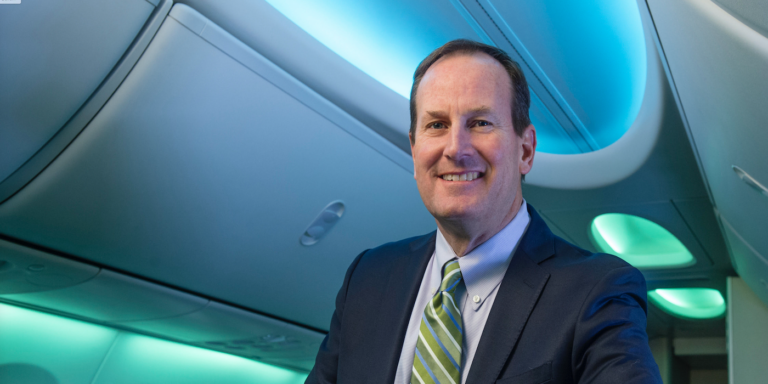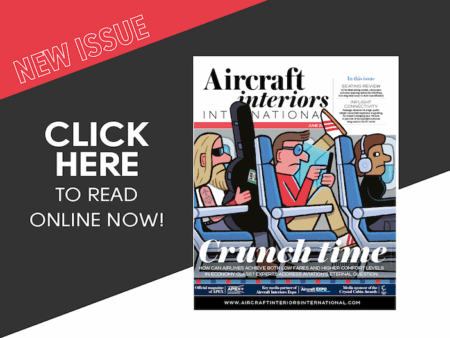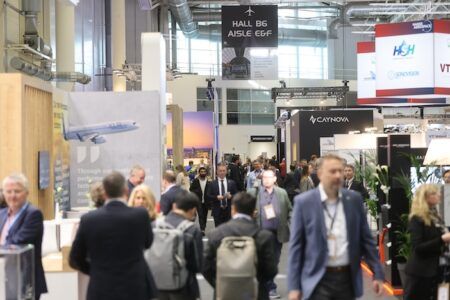In recent years, a major talking point in the cabin interiors sector has been supply chain issues. Indeed until ‘Bumpgate’, United’s biggest issue was the no-show of many of its Polaris business class seats, and several other airlines have suffered with seat delivery issues. However, despite such problems, Boeing reports that 2016 was a record year for the company in terms of seat delivery, with a full 10 months of on-time deliveries reported: the first time this has been achieved since 1999.
A key figure in Boeing’s seating activities is Alan Wittman, director of the seat integration team (nominated CEO of Adient Aerospace in March 2018), who says that while this milestone is positive, deliveries are “still an issue”, as any one program can create knock-on problems. Wittman’s team is on the case though, resolving identified issues – including the delivery of United’s delayed Polaris-equipped B777-300ERs, which “won’t take much longer”, as he said during our talk in April 2017.
A man of principles
In Wittman’s eyes, there are many factors involved in a successful seat supply chain, and his team has established a set of principles that they focus on. One key principle is design and build quality, ensuring that the product on a Boeing aircraft “performs better than the competition, and is reliable and maintainable”, as Wittman says.
Wittman is also keen on delivery discipline, with world-class customer support. “In the seating world delivery discipline has been a challenge, and a root cause of some of those challenges has been design and build quality,” he adds. Indeed, earlier this year Boeing hosted an event in Seattle, Washington, that saw the team spend a full two days talking with suppliers about design and build quality, and what Boeing expects of them (see p56).
In line with Boeing’s increasing production rates of certain aircraft lines, Wittman’s team is also being proactive in ensuring they create enough support and capacity for customers by teaming up with a variety of seating suppliers. “We also share with suppliers that aviation is a great growth industry for all of us and we’re all in it together,” says Wittman.
“In recent years it has taken a lot of work to step up our suppliers and our internal capabilities to meet the demands of these growing production rates, and we
have been largely successful,” Wittman adds. “We work proactively and think ahead, not just in months, but over five, 10, 15, 20 years, because our 20-year outlook predicts long-term growth and we have to make sure we have the capabilities and suppliers to support that. We develop strategies for what we will need in terms of seat products and technology, and supplier capacity and performance.”
Blossoming relationships
As part of its supply chain strategy, Boeing has been developing relationships with several companies over
the past four years, including ZIM Flugsitz, Thompson Aero Seating and Recaro, which Wittman says have been a success in terms of line-fit product, and he is “really happy” with the performance of these partnerships.
To broaden customer choice and raise capacity potential, Boeing has also been investing energy in developing relationships with new seating suppliers, notably LIFT by EnCore, Jamco and Adient.
j’adore EnCore
Following a successful start to EnCore’s new LIFT seating division with its Tourist Class economy seat designed specifically for the B737 Boeing Sky Interior, the collaboration is now being expanded to include
a seat designed specifically for the Dreamliner cabin.
“The collaboration has been fantastic, and it’s going faster and faster as we build our relationship,” says Wittman. “They’ve invested in all the right ways, with test sleds, you name it. They’re going to vertically integrate, build more seats and perform, which is something customers are looking for. The wide-body seat needs more comfort features than the B737 seat [hence the addition of a cradle effect], but it’s the same concept, just spatially, structurally and aesthetically optimized for the B787 instead. When you design a product for a particular airplane, you can take advantage of specific dimensions that help create a sense of space that isn’t available to other seating companies.”
j’adore Jamco too
Another of Boeing’s close collaborations is with Jamco, for business class projects including the forward-facing Journey B business class seat and the herringbone Venture seat, both also optimized for the B787 interior spatially, structurally and aesthetically.
“Jamco is a great partner of Boeing and we have a long relationship [Jamco enjoys an almost 50% share of the lavs market]. The company has grown its seat business over the past five years to something significant, and they have great capability,” states Wittman.
“With any company, people can make promises and then not keep them or make mistakes. But Jamco has long relationships with proven performance and proven trust, plus they’re pretty conservative about what they sell and we trust they won’t overcommit themselves.”
To help prevent supply problems, Boeing carries out production readiness assessments, with a lot of math going into assessing production capabilities, and then they collaborate with the suppliers to make sure their figures agree. “But we’re not there every day when they’re selling seats, so we trust they will stick to that line,” adds Wittman. “Jamco’s seats will be in the B787 catalog soon; we are working on putting them in this year.”
Retail therapy
Speaking of the Dreamliner catalog, how is it shaping up? “The B787 catalog has changed over the last couple of years; it’s not the catalog we started with,” says Wittman.
“The SFE model initially set for the B787 really didn’t serve the market as intended. We do still have the Dreamliner Gallery [a showroom in Everett where customers can view and try out catalog products] and Jamco will be in the Gallery soon with the Journey and Venture seats. Ultimately we work together to choose which customers we offer [seating product] to on a campaign basis. We do project-based offerability.”
Adient drives in
The latest big news for Wittman’s team is that Boeing
has entered into a collaboration agreement with Adient – a world-leading automotive seating company – to build aircraft seats. One in three car seats in the world are manufactured by this company, and it is now widening its focus, with a goal of achieving US$1bn in annual revenues from non-automotive markets over the next five years.
“We’re excited about getting that kind of expertise and capability in the aircraft sector. Adient has really strong capabilities in design, quality, craftsmanship, supply chain and industrialization: a lot of the things that frankly the aircraft seats and interiors market has been lacking. We’re really excited about working with them to see what we can create for aircraft seating,” says Wittman.
“Again it’s about creating new ways to offer more choice and more value for customers. They are a strong company with a lot of capability and we are excited about getting a company like that with a background of proven performance into this industry.”
Adient has developed prototype seats and is working quickly through the industrialization process, but both Adient and Boeing say it is too soon to say when they will be ready to go public with the designs.
“Adient is a large, capable company so they are looking at the whole seating market. Where the collaboration comes in is they are relying on us to teach them how the industry works from a certification and technical perspective.”
Meanwhile Adient will contribute new perspectives in terms of design, comfort, craftsmanship, operation and supply chain.
Collaborate to accelerate
Boeing stresses that by collaborating with its engineers, suppliers can develop product with fewer design iterations than when they do such work on their own,
as they can be provided with all the environmental, structure and stress specifications of a particular aircraft at the start of a project.
“Our collaboration strategy is that we’re always looking for new opportunities, whether to solve particular pinch points or to introduce a new capability on the market that can add value to customers,” says Wittman. “It’s about creating choice for customers.”





